Perhaps one of the most surprising signings in a January transfer window came to pass on deadline day, as Liverpool belatedly moved for not one, but two centre-backs to try and ease the injury-enforced crisis at the club, at least in terms of available defenders. The Merseyside club brought in Ozan Kabak on loan from Schalke in Germany, with an option to buy in the summer as well. Kabak has been highly-regarded for some time, and was linked to Liverpool during the summer window as well, so this move did not come as too much of a surprise. However, the other arrival at Anfield has certainly raised eyebrows in some quarters, with Ben Davies being signed from Preston North End for a fee of £500,000, with a further £1.1m in performance-based add-ons. A mid-table Championship side would not normally be regarded as a hunting ground for players to come in and make an immediate impact at the top end of the Premier League and potentially even the Champions League. However, Liverpool are confident that Davies can make the step-up, and he does have some attributes that could be well-suited to playing for the Premier League champions.
In this scout report, we will look at how Davies can slot into the Reds’ lineup, and what Liverpool fans can expect from him in terms of his playing style, strengths and weaknesses.
Playing and statistical profile
Davies is a 25-year-old centre-back, who has also played at left-back throughout his career. He came through the Preston academy, and has had loan spells at York City, Tranmere Rovers, Southport, Newport County and Fleetwood Town, before establishing himself in Preston’s first team in the 2017-18 season. He has usually played as the left-sided centre-back for Preston this season, but has also played at left-back earlier in his career, and can step in there if needed. His heatmap for the season so far shows the sort of positions he takes up –

We can clearly see how Davies was used on the left side of the defence here. It is also interesting to note that Preston, under Alex Neil, have been a relatively high pressing side, and also play with a high line of sorts, both of which should theoretically allow him to settle in without too much trouble at Anfield.
On comparing Davies with other centre-backs from the Championship this season, we have noticed some interesting traits and aspects of his game from the statistics. All data is from Wyscout, and we have only considered centre-backs who have played at least 800 minutes in the Championship this season, to provide a big enough sample and therefore allow us to make comparisons that are relevant.
Our first scatter plot looks at defensive duels/90 and possession-adjusted (PAdj) interceptions, while the colour of the plot indicates the player’s success rate for defensive duels.
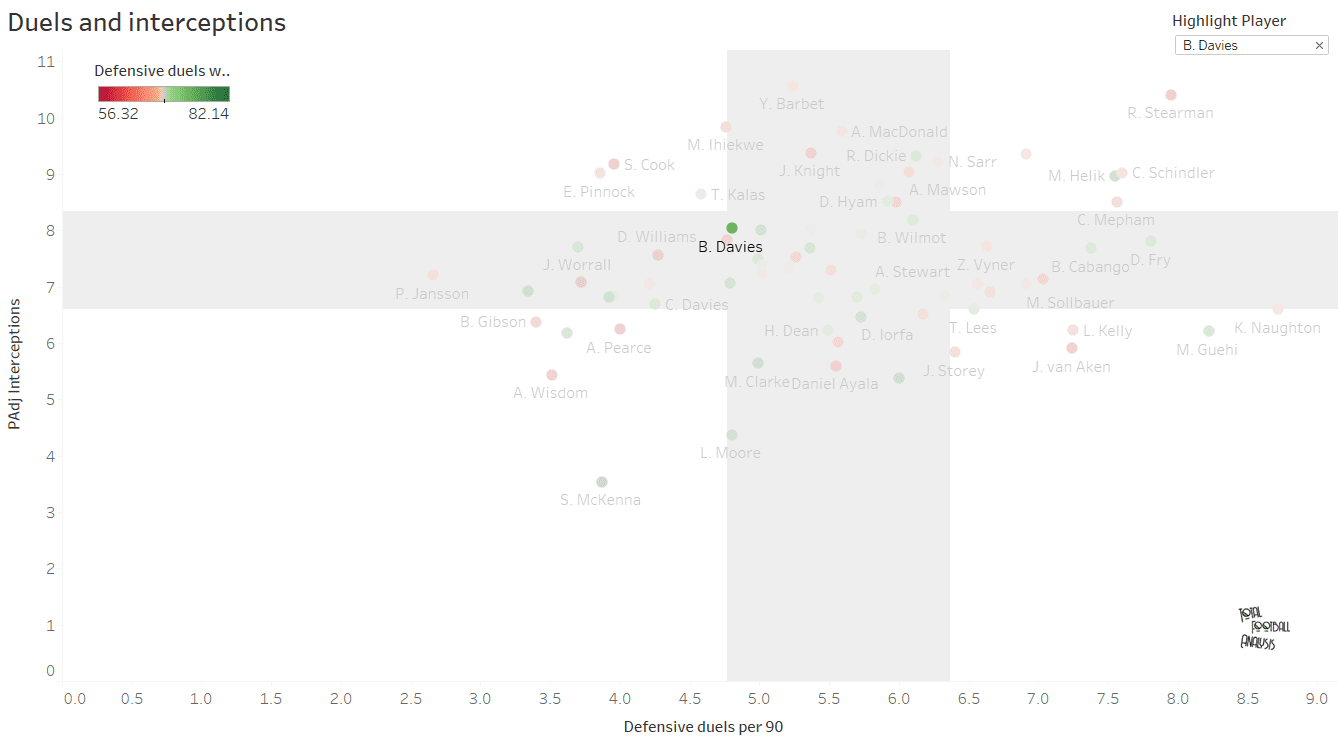
We can see that Davies has been around the league average for both metrics, with a propensity to make interceptions – he has made 8.04 PAdj interceptions per 90 in the Championship, while being involved in 4.8 defensive duels/90. He has been quite successful in those duels, with a success rate of 74.2%, which indicates that while he may not get into too many duels, he does win those he gets involved in. Davies is not the most physically imposing centre-back – he is 6’1″ and weighs 74 kg, and thus fans should not expect him to be able to dominate opposition attackers in the manner that Virgil van Dijk does. However, he does seem capable enough of nipping in front of attackers to win the ball back, or cutting out dangerous passes, based on the chart above, and Liverpool fans can expect more of the same.
The next chart looks at his passing ability – an extremely important quality for a Liverpool centre-back, and it is arguably the loss of van Dijk’s, as well as that of Joe Gomez and now Joël Matip’s ability to pass out from the back that has hurt Liverpool more this season than their defensive ability.
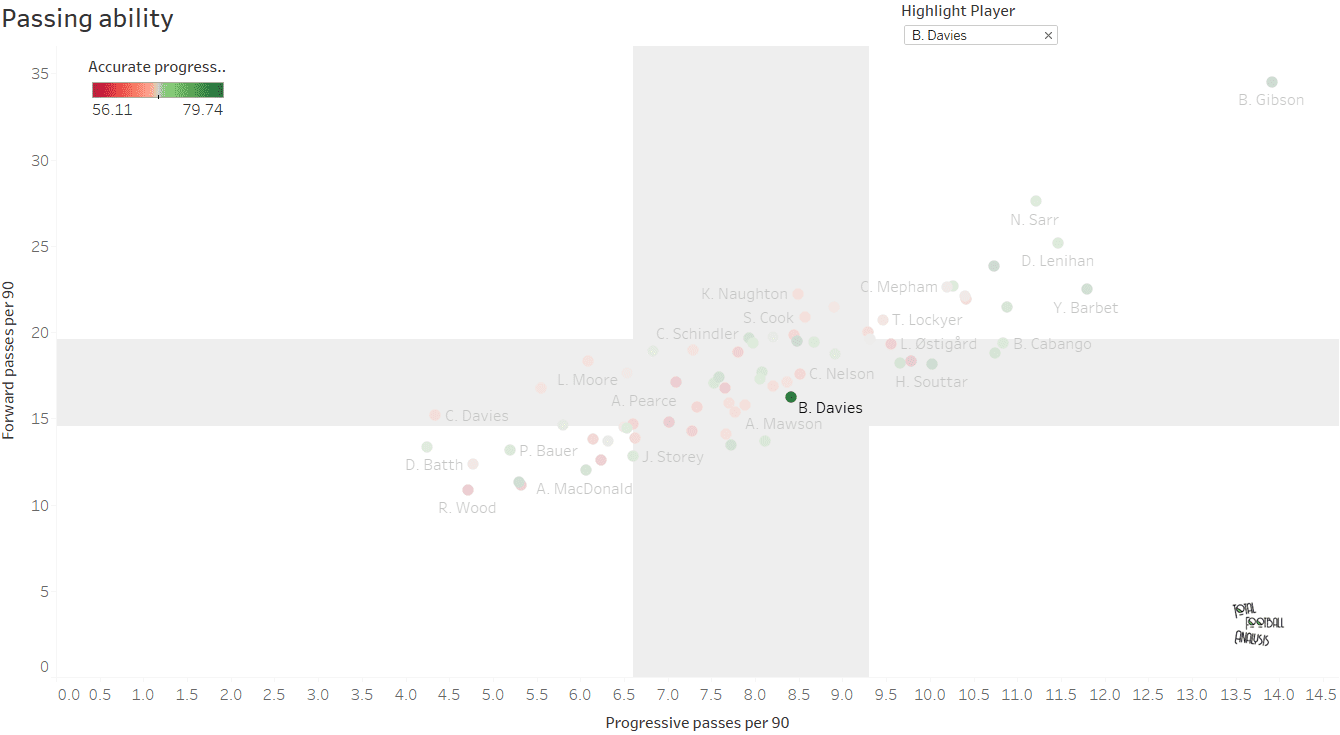
This chart looks at progressive passes and forward passes per 90, with the colour of the dot indicating the success rate for progressive passes. It is evident that Davies is more than competent in playing these type of passes – he is again around the league average for both metrics, having made 8.41 progressive passes per 90, with a 78.8% success rate, and 16.2 forward passes per 90. This will be one of the areas where Davies will be expected to have an immediate impact – Liverpool have struggled to progress the ball as quickly as they used to from their defence into the wide areas, and this has led to the likes of Trent Alexander-Arnold and Andrew Robertson not being as effective as they have been for the last couple of seasons. As a left-footed centre-back, he will also provide alternate angles for ball progression and passing, and as the only left-footed centre-back in Liverpool’s squad, it will be interesting to see the impact that this will have on their build-up play.
Our last chart, before we dive into in-game examples of Davies’ traits, is a look at aerial duels.
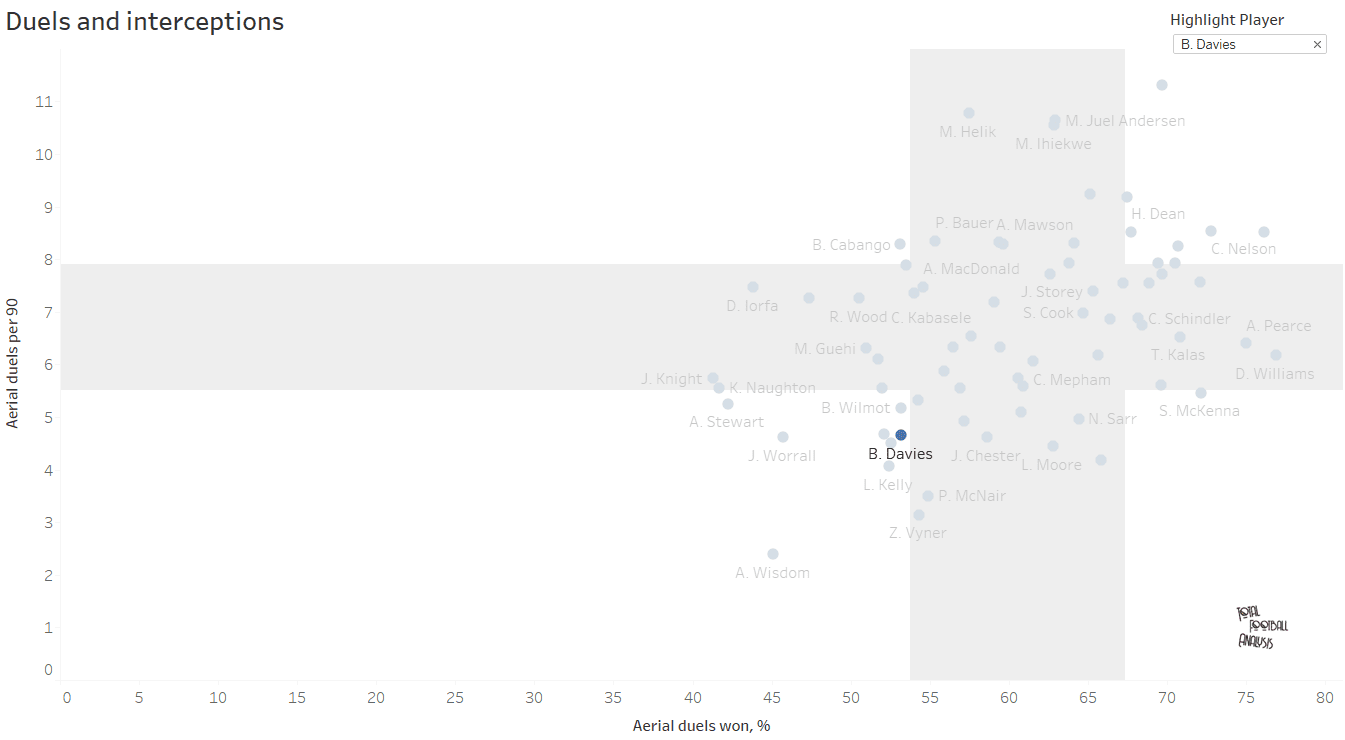
We can see that this is not an area where Davies is strong, he is ranking below the league average for both the number of aerial duels that he contests per 90 minutes, as well as his success rate for them. This could be a potential issue at Liverpool, given that they will often come up against sides which will look to play a direct style of football against them, and therefore play long balls up to a target man or send in crosses into the box from wide areas. Liverpool fans will hope that his centre-back partner, whether that is Fabinho, Kabak, Jordan Henderson or anyone else, can mask these deficiences as much as possible, while allowing Davies’ strengths to shine through.
We will now take a look at some in-game examples to showcase Davies’ traits, both in and out of possession.
In possession
As stated earlier, the former Preston centre-back is more than proficient at playing longer passes out from the back – a trait that will be required of him as part of the Liverpool backline. He has the ability and vision to spot players on the flanks, or even centrally, and then find them with a variety of passes. His passes to the flanks are usually helpful in getting a player to receive the ball in space, and thus this could be extremely beneficial to Liverpool’s full-backs, as well as Mohamed Salah and Sadio Mané.
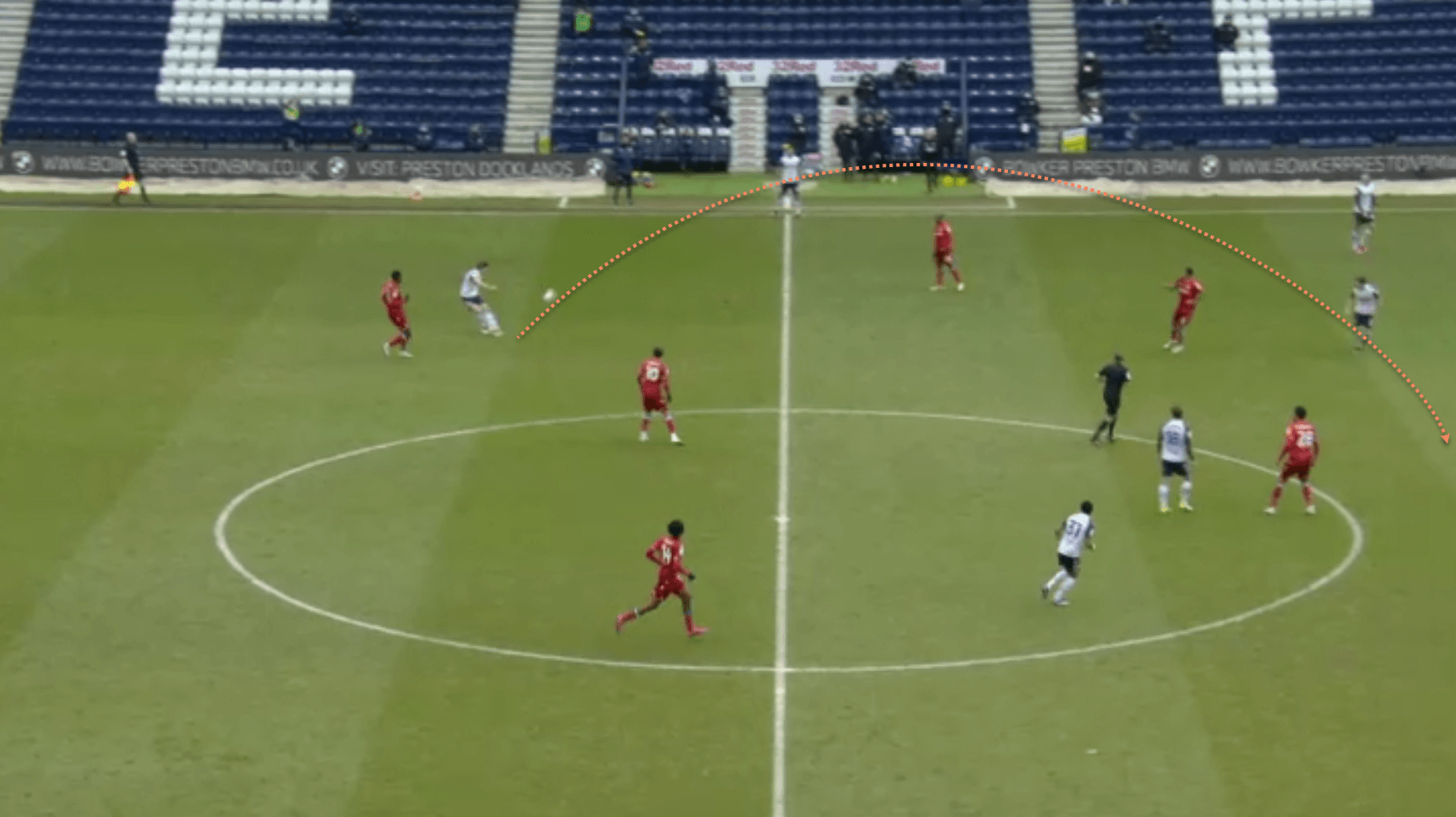
Here is one example of such a switch of play – Davies is able to move up to near the halfway line on the ball, and then spots an opportunity to switch the ball out the right…
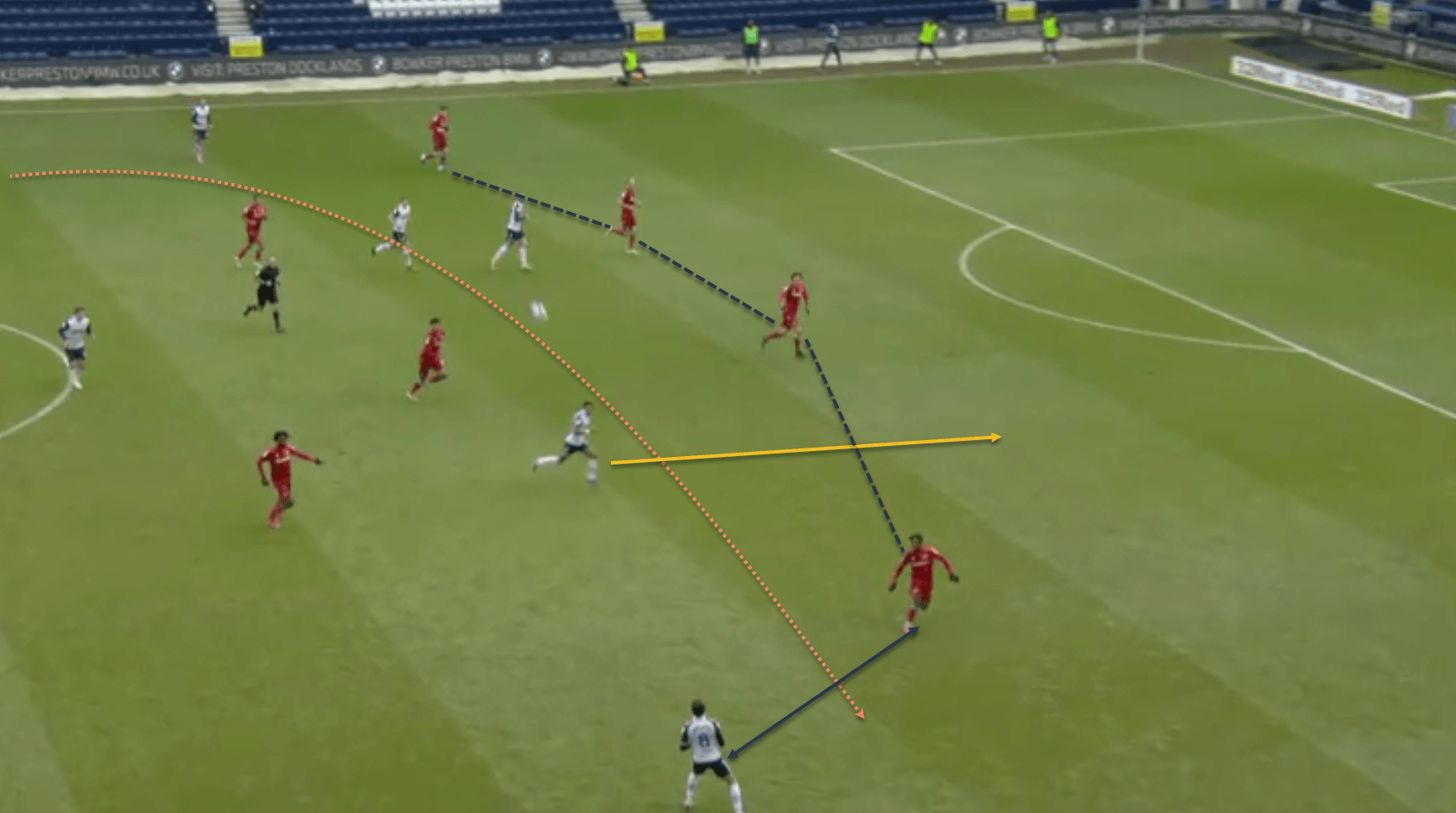
…where his teammate is able to receive the ball in space. Also note how the opposition left-back, in sprinting out to cover the space, is leaving a huge gap in behind for the Preston midfielder to run into, which could be exploited if the right pass is made.
Davies’ ability as a left-footed centre-back allows him to play these sort of passes well, with the natural angle helping him to switch the ball towards the right. However, he is equally proficient at moving the ball in a similar manner down the left flank as well –
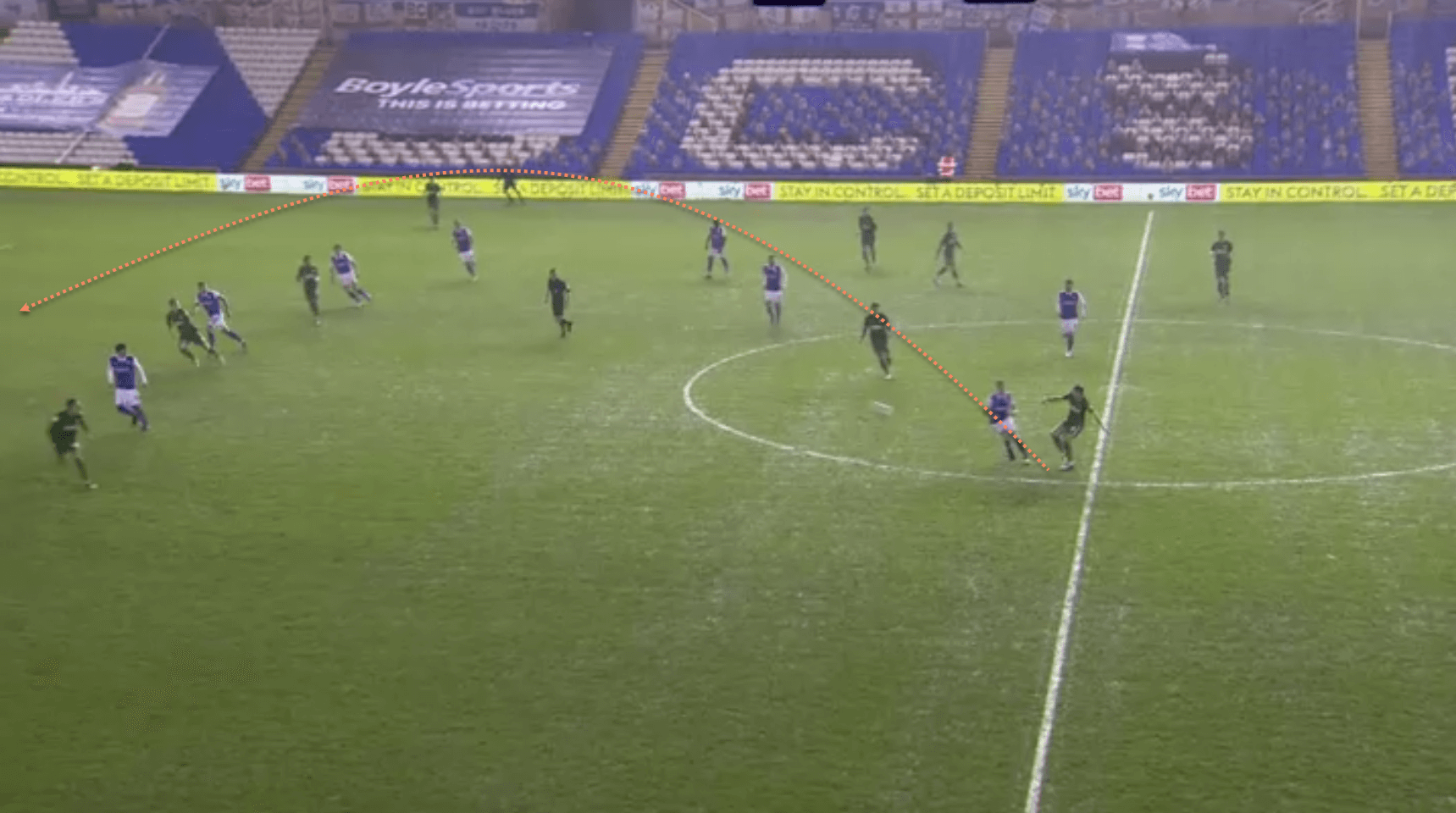
Once again, Davies is in an advanced position, just inside the opposition half in fact, and is able to play a long pass out to the left…
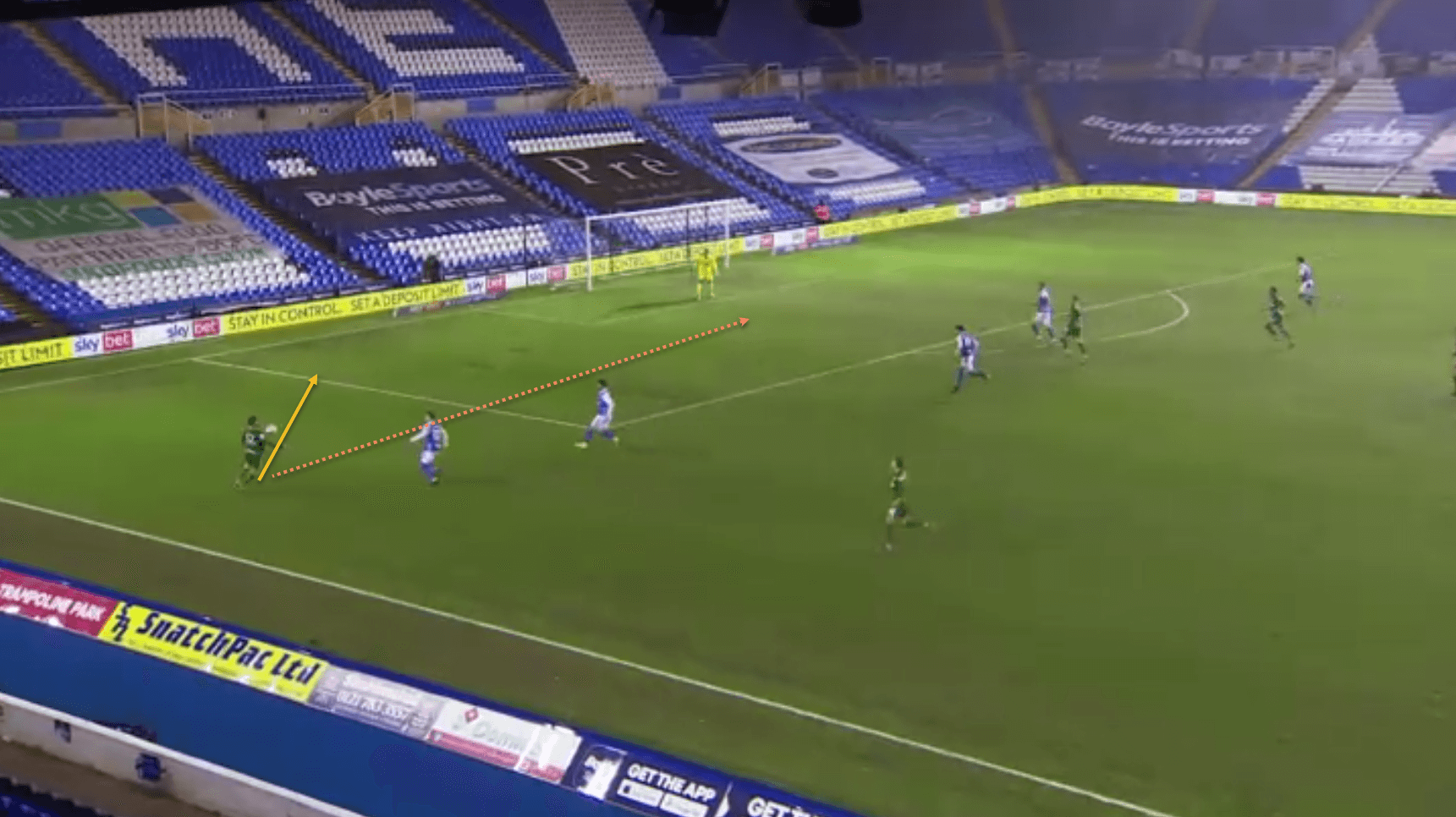
…where his left-back receives in space, able to drive into the box or cross early for the striker as a result.
This ability to step out of defence and play passes to players in space is something that Liverpool have lacked this season with van Dijk’s absence, and even more so now that we know that Matip is also unlikely to play again during this campaign. Both centre-backs are extremely good at moving forward with the ball to the half-line and beyond and then playing these sort of passes to the wide men, or centrally if the opportunity presents itself, and Davies will hope to be able to fill that need immediately.
Another area where this trait can be utilised by Liverpool is in defensive transition. Davies was not shy to play this sort of pass, even when recovering the ball high up the pitch and therefore not having any cover behind him in case the move broke down or his pass was inaccurate, and this will be handy for Liverpool when they try to maintain pressure on opponents.
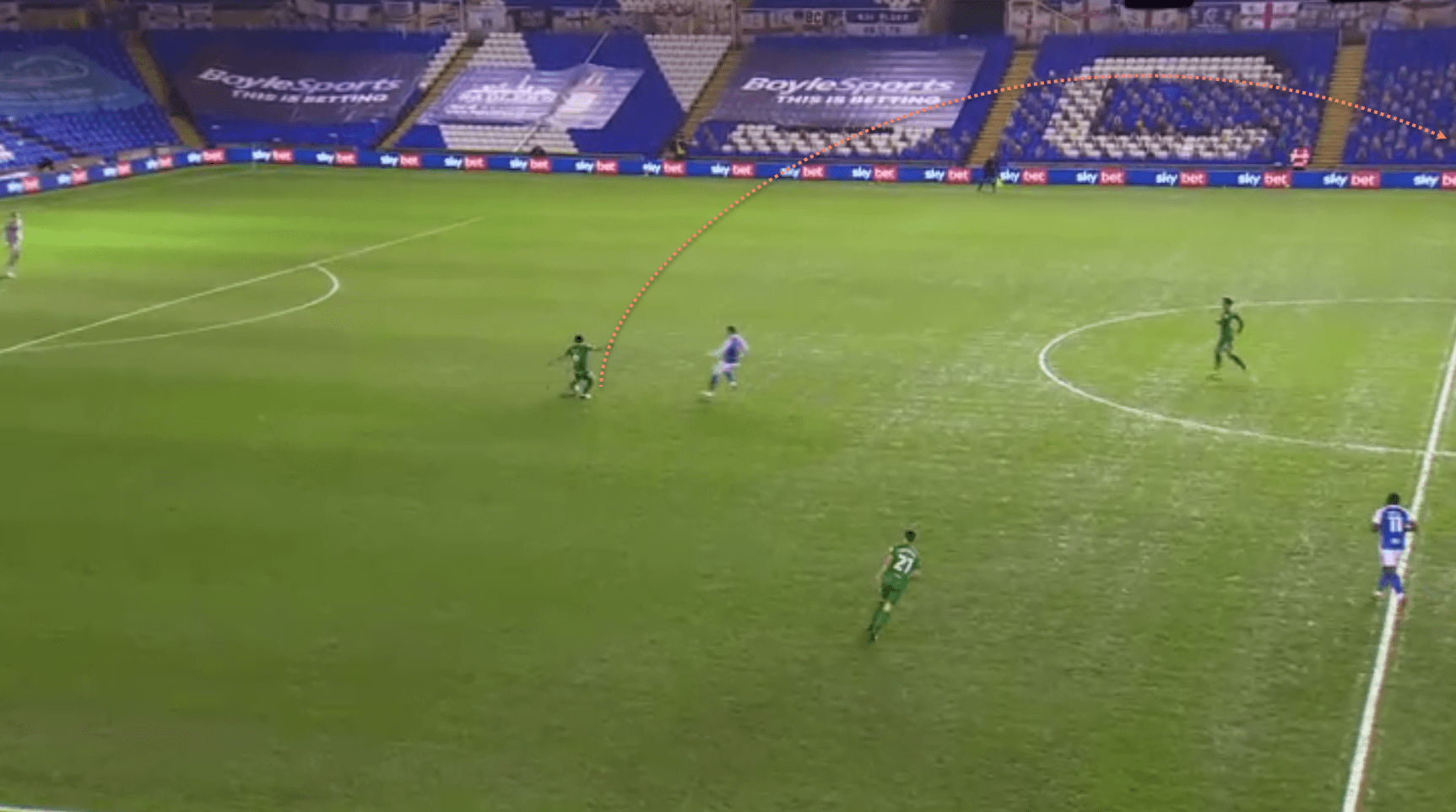
Davies is in a deeper position in his half, but has just received the ball after a Preston attacking move broke down. He chooses to pass out wide here rather than play a safe pass…
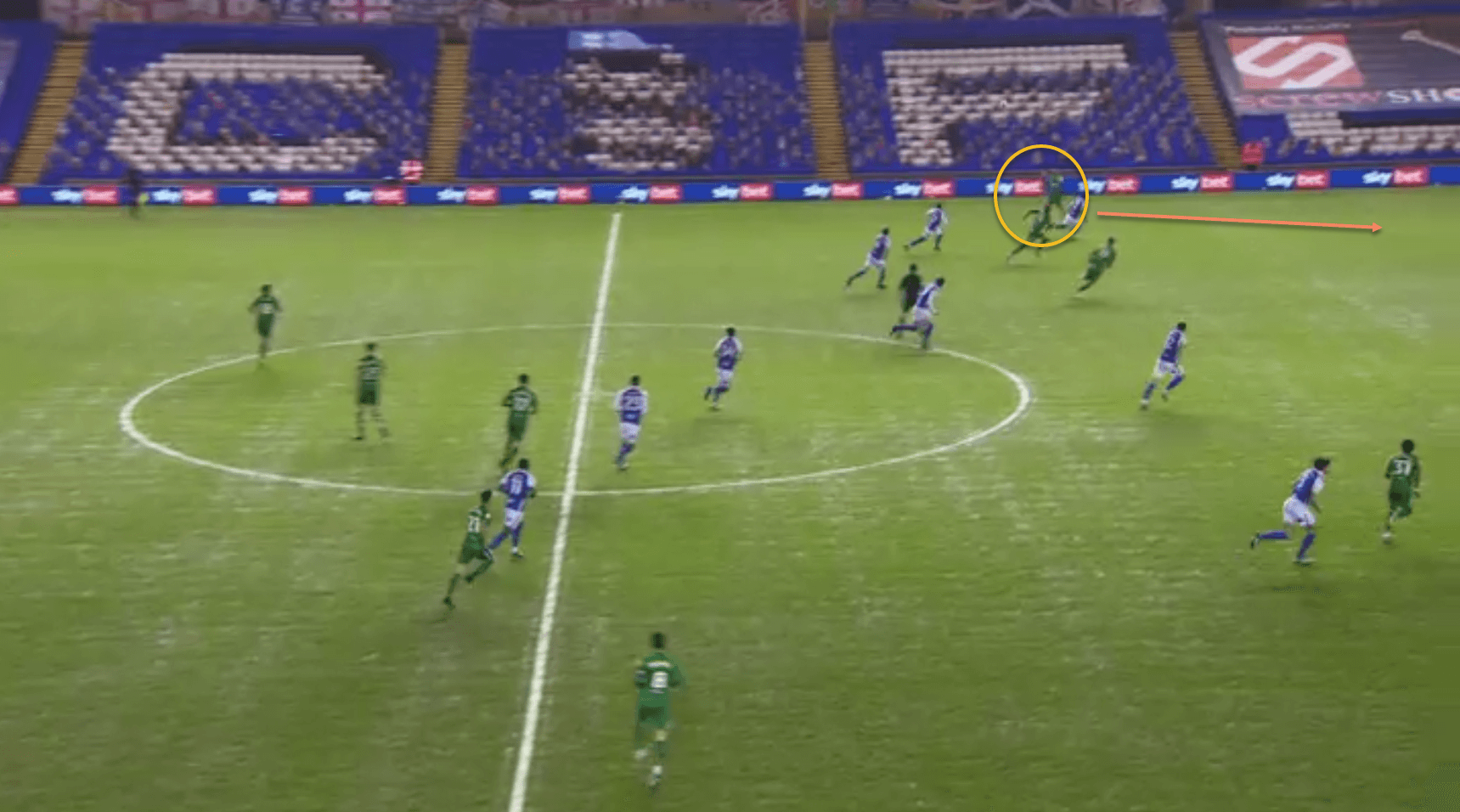
…with the result that the wide player is again receiving the ball in space, and has room to run into.
The 25-year-old is also capable of playing these sort of passes from higher and wider positions on the pitch, when needed, thus showing how he can be a vital tool for Liverpool to improve their ball progression and build-up play.
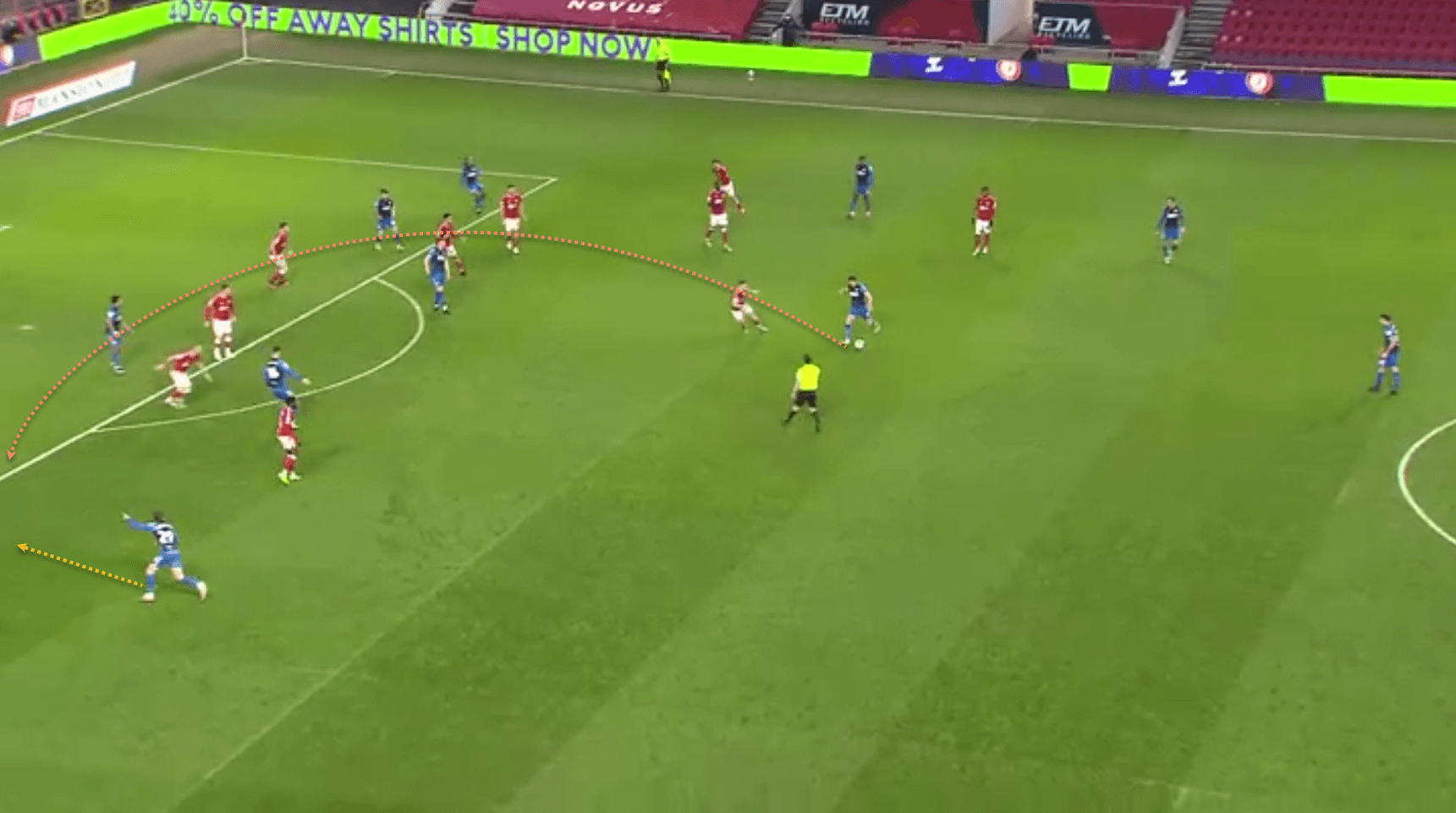
This situation develops when a Preston free-kick into the box is cleared – Davies picks up possession and immediately looks to play the left-back into space with a pass over the defence.
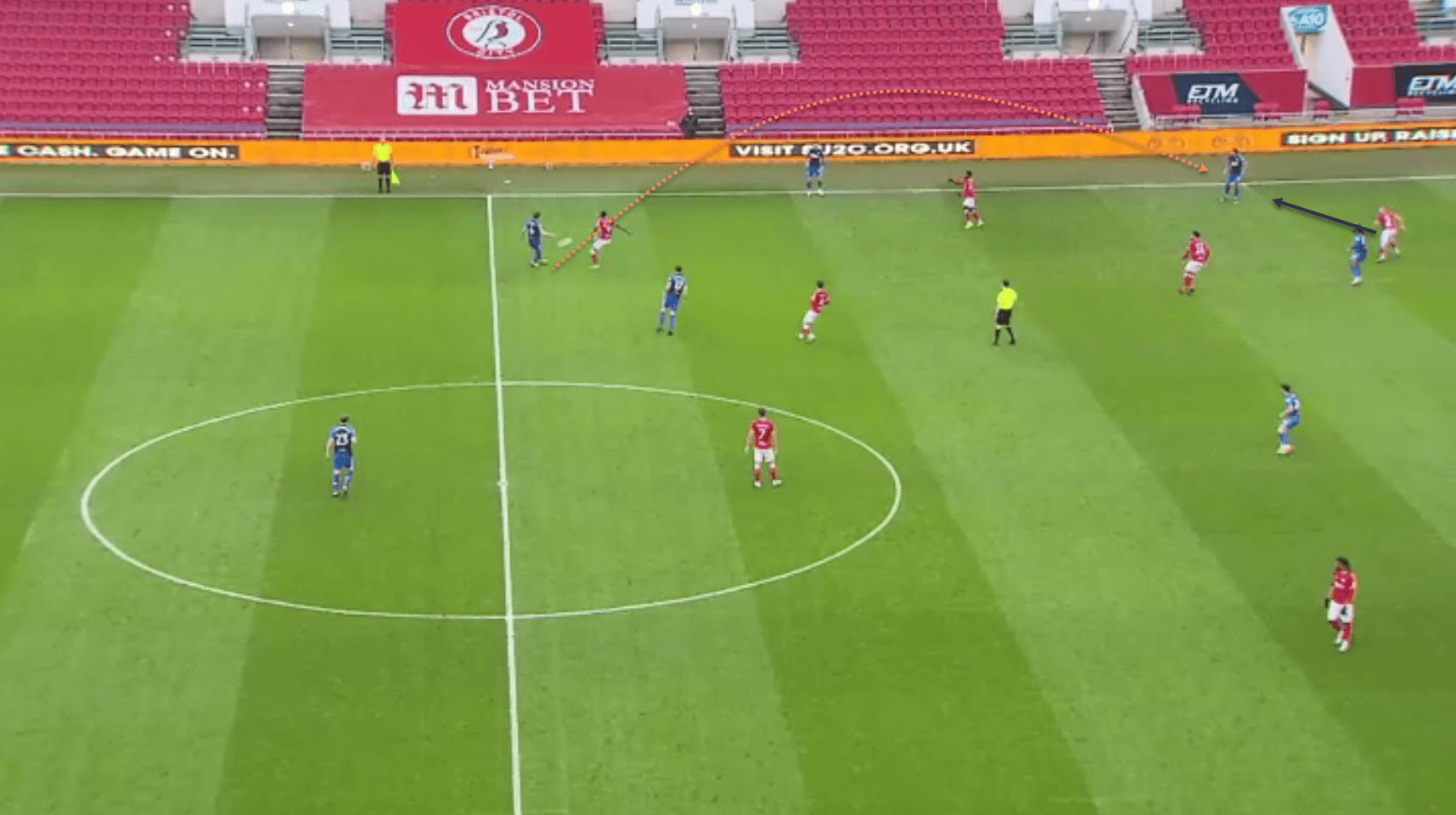
Here, Davies steps out of the backline towards the left flank, and is then able to play a chipped pass to the winger, bypassing the opposition midfield and allowing him to receive in space, with the opposition right-back scrambling to close him down.
Davies does look to play safer passes when deeper in his own half, but even then he often looks to switch play to the full-backs to escape pressure. These traits will be a good fit for a Liverpool side who still predominantly attack down the flanks, and the 25-year-old should be able to spark an improvement in their ability to find those full-backs and wide attackers in space more often than they have this season.
Out of possession
We have already seen that Davies is not the best in terms of aerial duels, and he is also not physically imposing. Thus, the Englishman tries to be intelligent with his movement and positioning to get the better of opposition attackers. He tries to nip in front and win the ball when a pass is played towards his target when possible, but otherwise usually tries to create separation between himself and the attacker to allow him to be able to clear the ball, while preventing the attacker from being close enough to interfere.
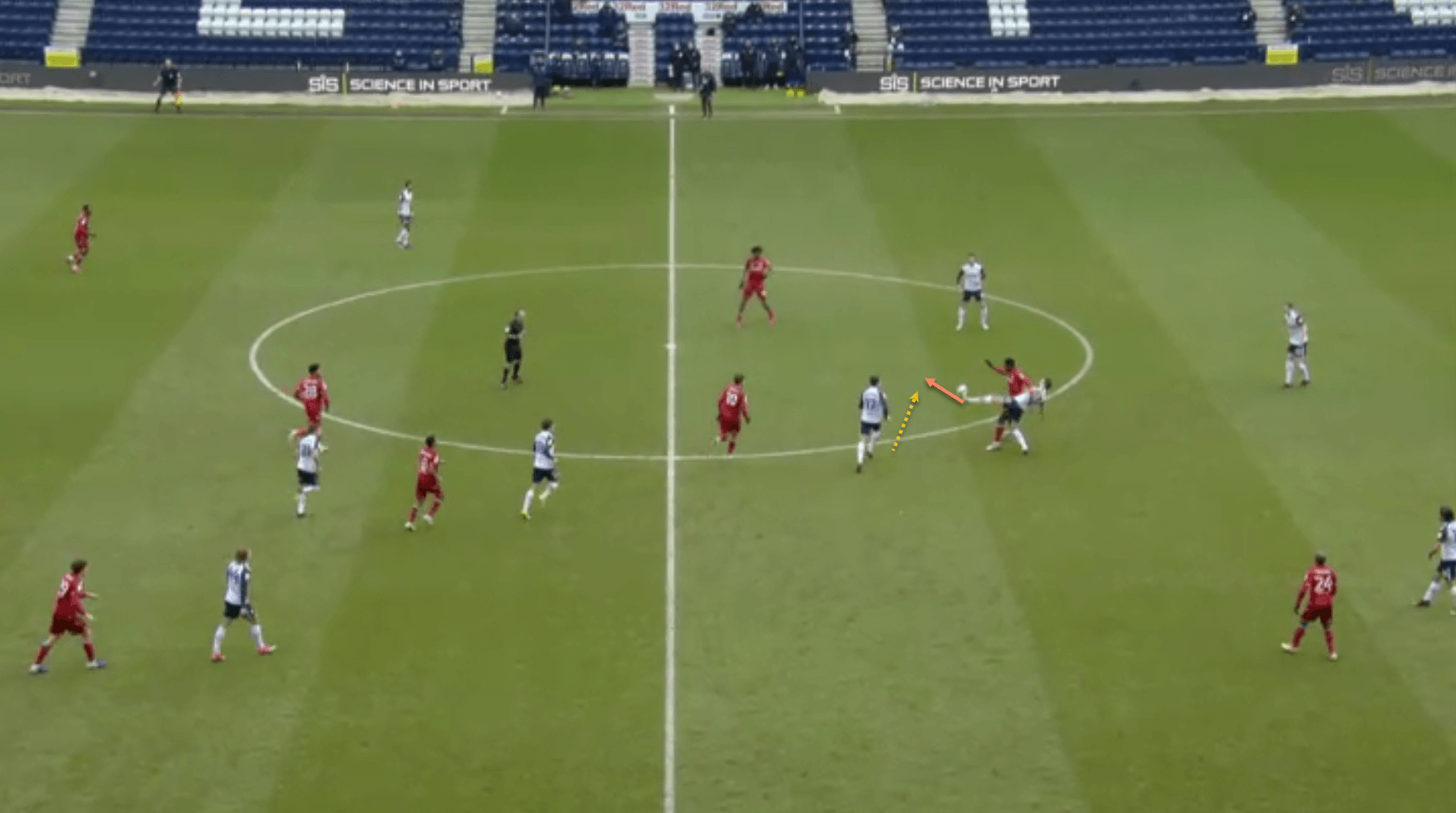
This is a situation where there is a clear physical mismatch, and Davies cannot hope to win the ball in a direct duel. Therefore, he levers himself to get a toe to the ball ahead of the attacker, and that touch allows the covering midfielder to pick up the ball and regain possession for Preston.
His anticipation and positioning are extremely good, and those characteristics allow him to be in the right place at the right time to clear balls into the box, despite his general weakness in the air.
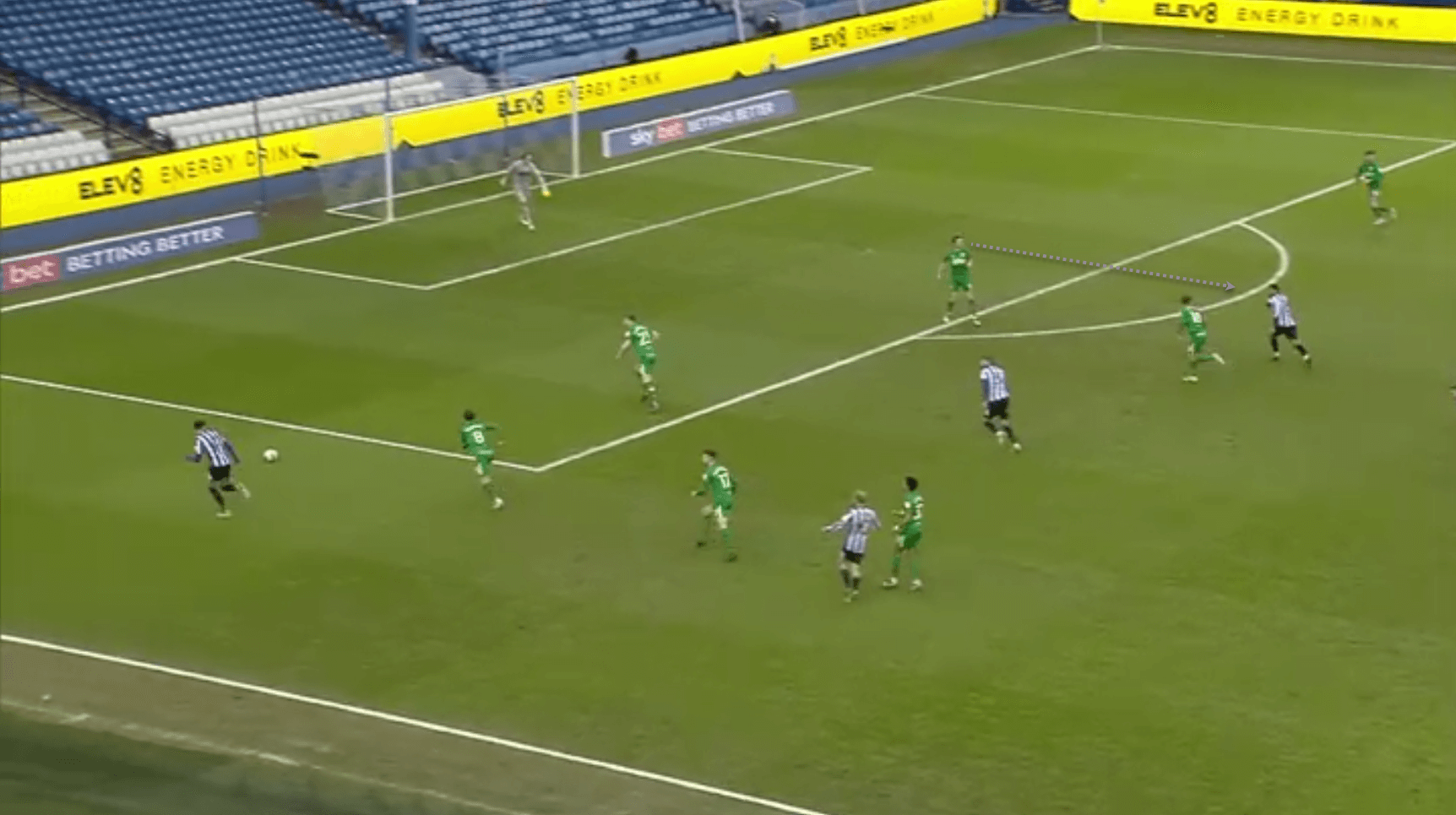
Note here, that when the ball is played out wide, Davies takes a look to assess the position of the Sheffield Wednesday attacker who is beginning to run into the box.
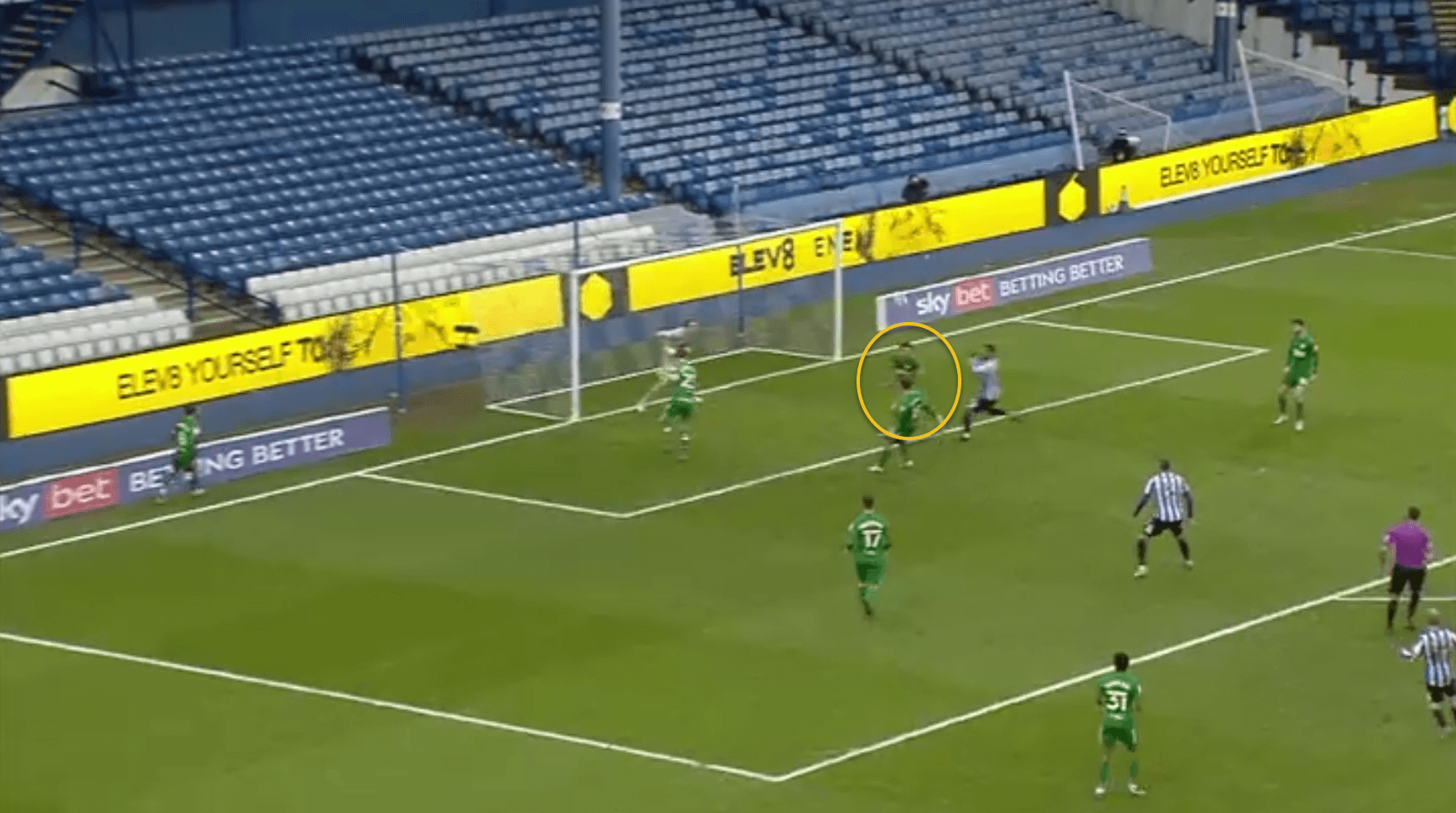
As the move developed, Davies took another look to be sure of where the attacker was, and was thus able to position himself in a way to head the ensuing cross away, ahead of the attacker.
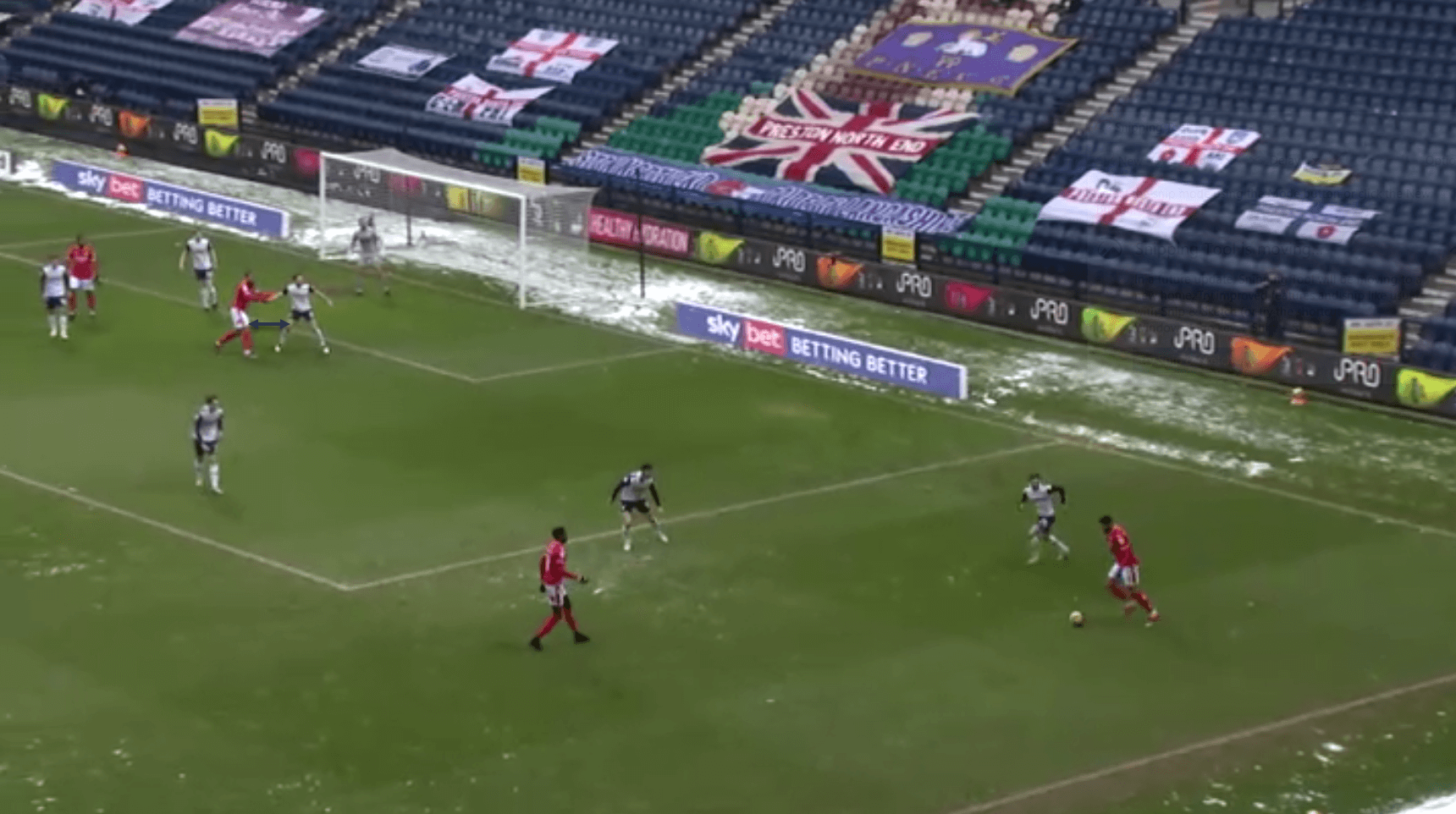
We see his penchant for creating separation here. Davies holds an arm out and literally holds the opposition striker at arm’s length, since he will not be able to compete in a physical duel in the air or the ground.
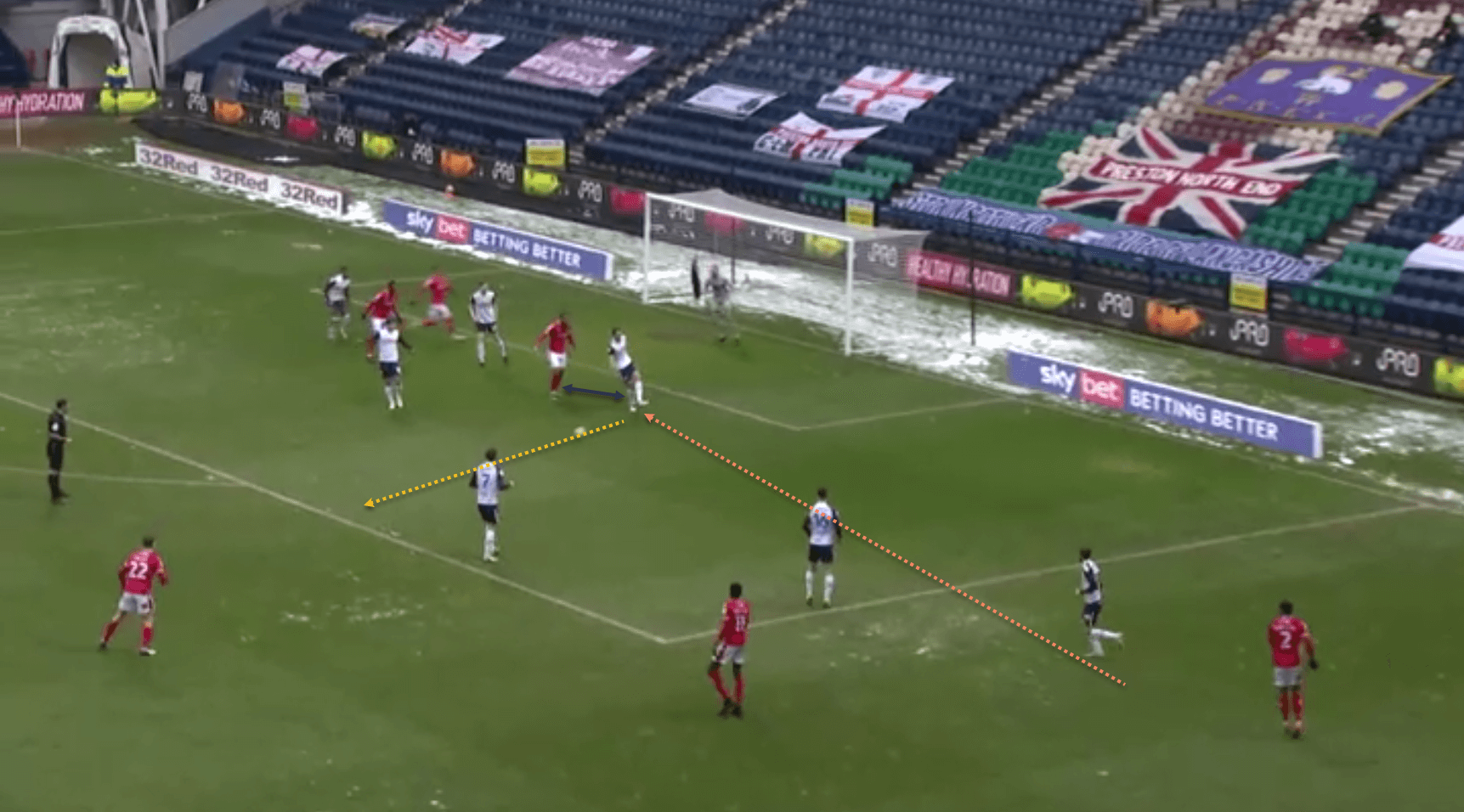
This allows him to get ahead of the striker and clear the cross when it is played into the box.
Davies is also not the quickest defender, and therefore usually looks to stay back and cover rather than dive into duels, since he does not have the recovery pace to get back if beaten.
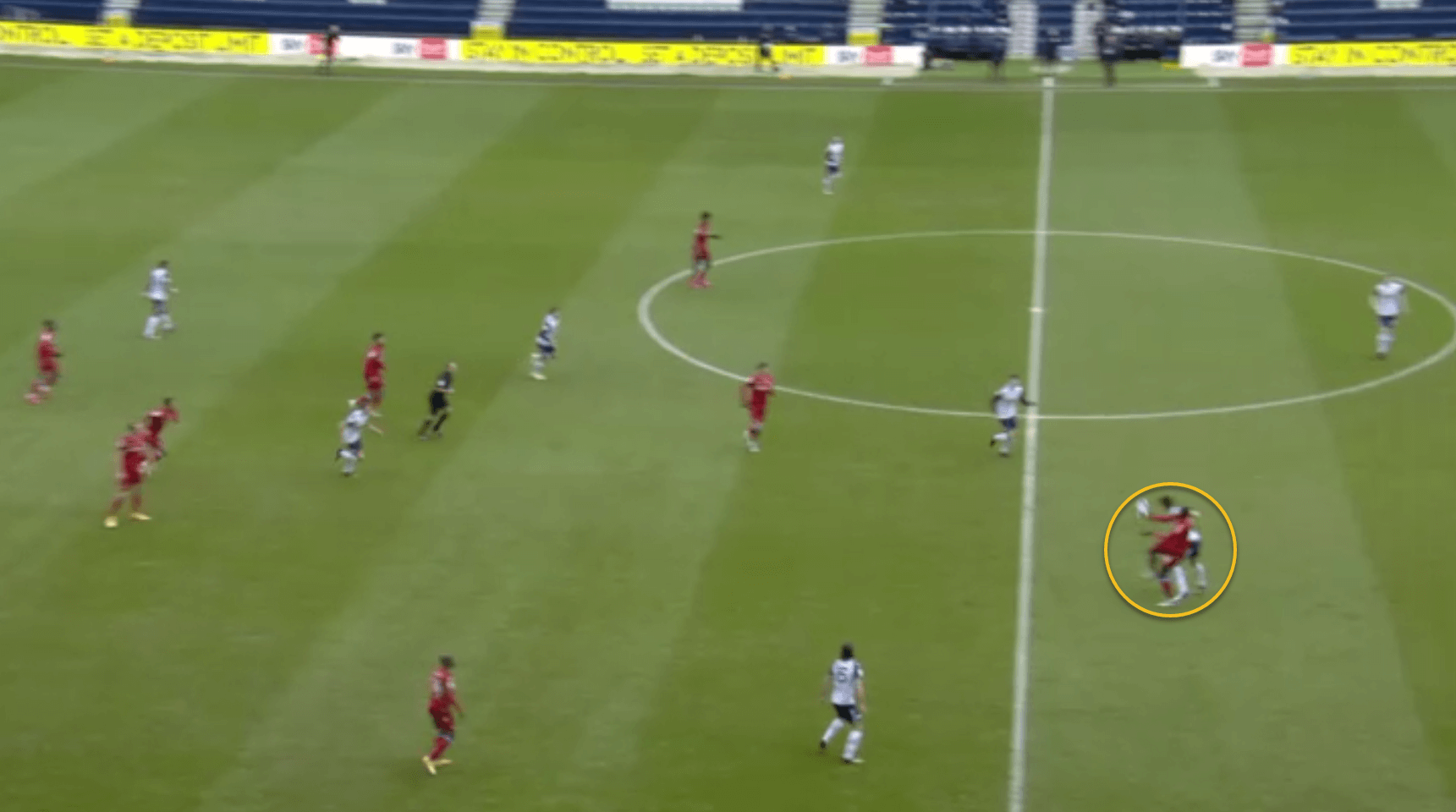
Davies actually gets beaten in this duel, and the attacker is able to come away with the ball. However…
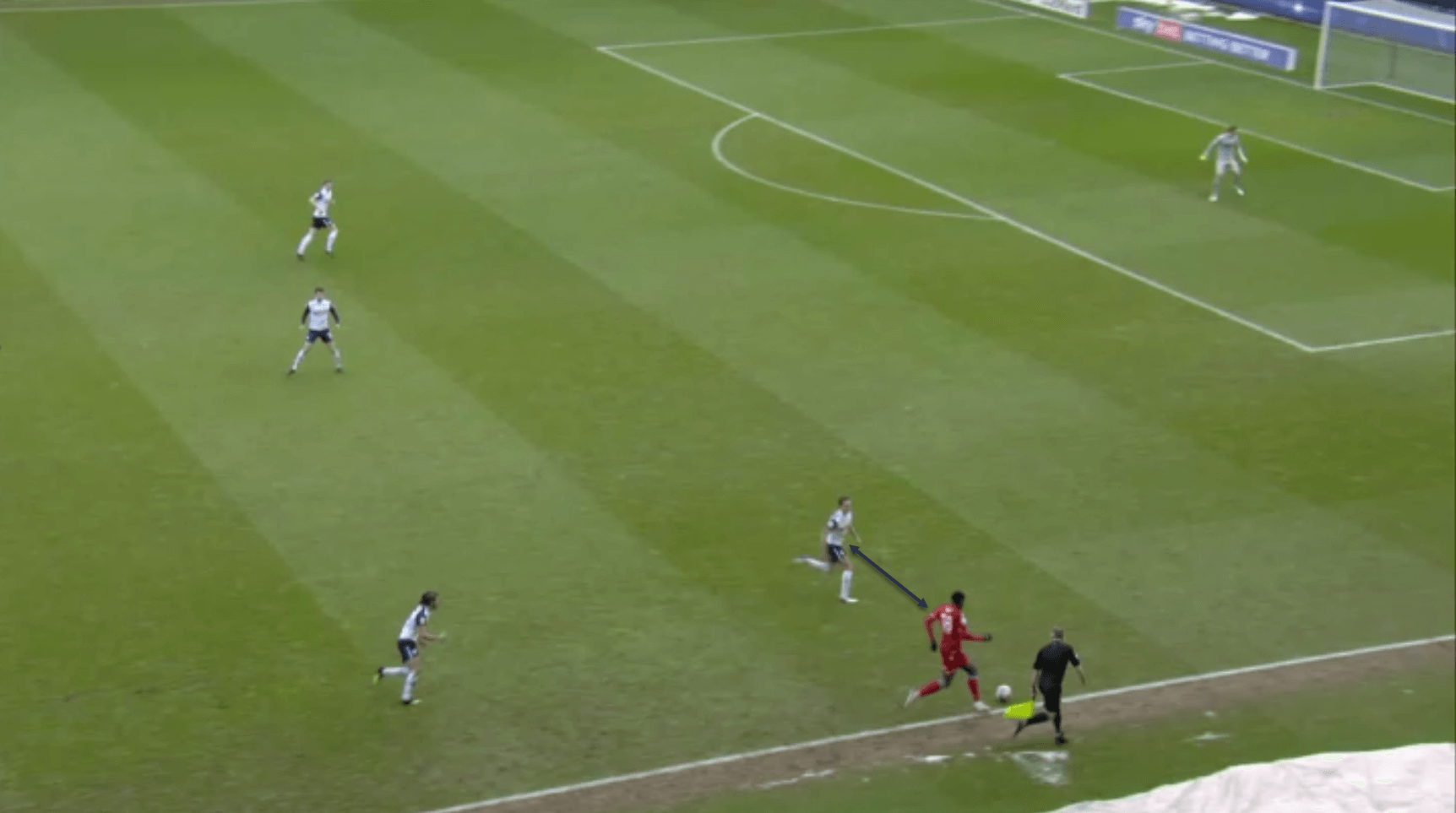
…the centre-back is able to keep pace with the opposition striker, and does not dive in here, waiting to assess and react to the situation as it plays out.
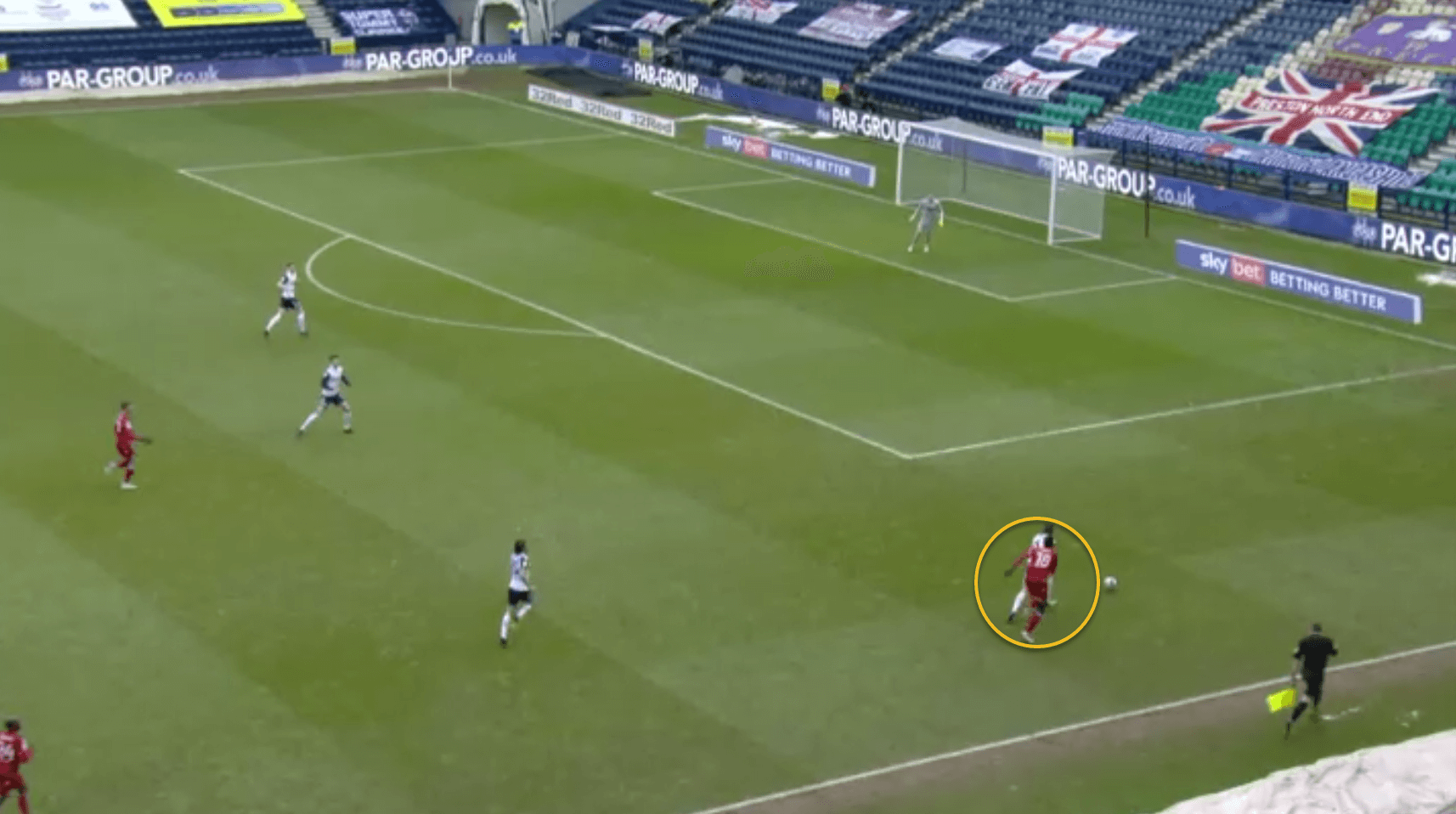
This pays off, as when the striker looks to push and run, Davies is in position to block him off and regain possession.
As the left-sided centre-back, he often has to defend in the wide areas as well. Here too, we see the same style of defending – looking to cover and create separation so that he has the time and space to react to the opposition’s decisions.
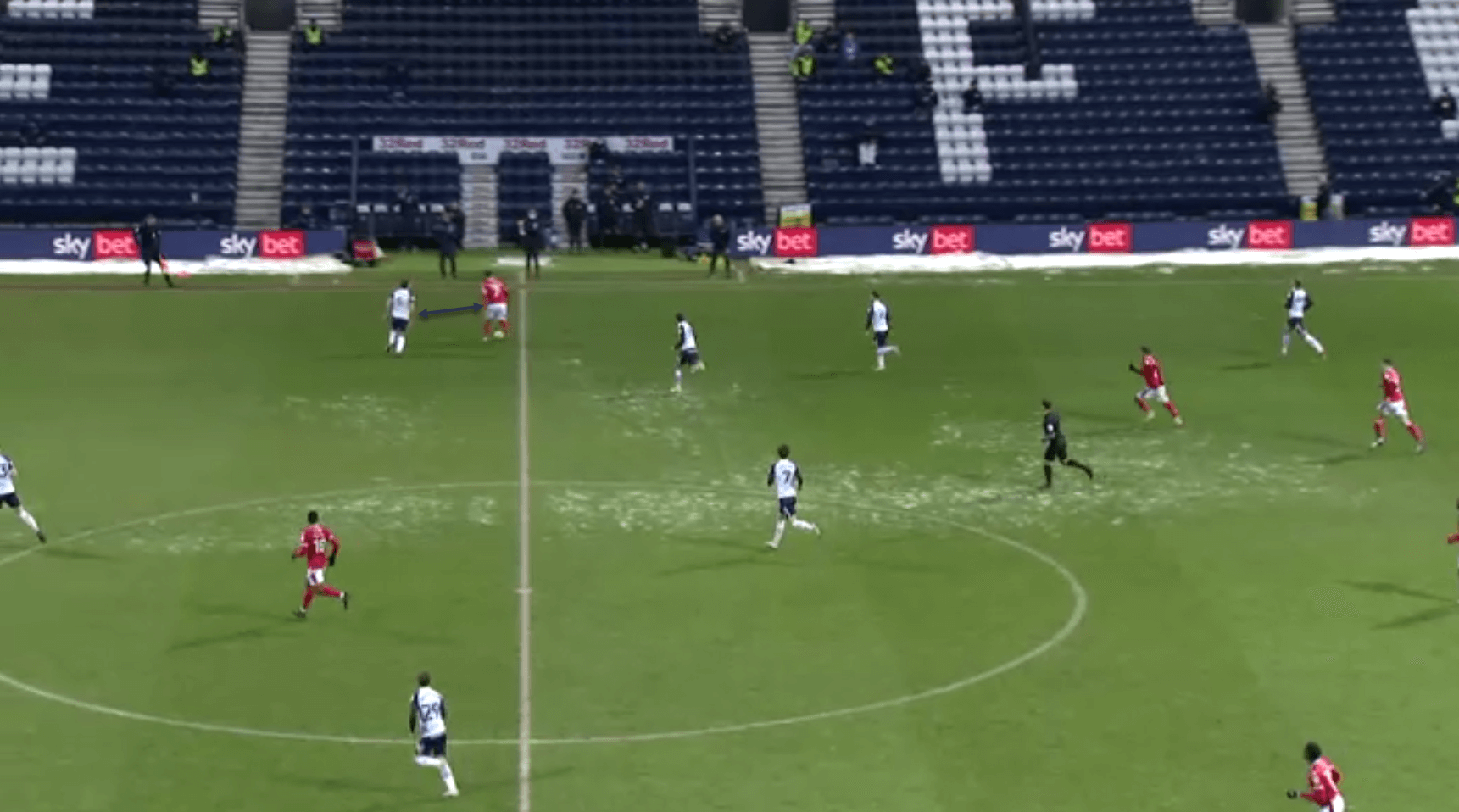
When the opposition player receives the ball in the wide space and Davies has to go out to cover, he elects to stay back and cover for potential runs rather than diving into the tackle – also because doing so could leave Preston exposed on a potential 2v2.
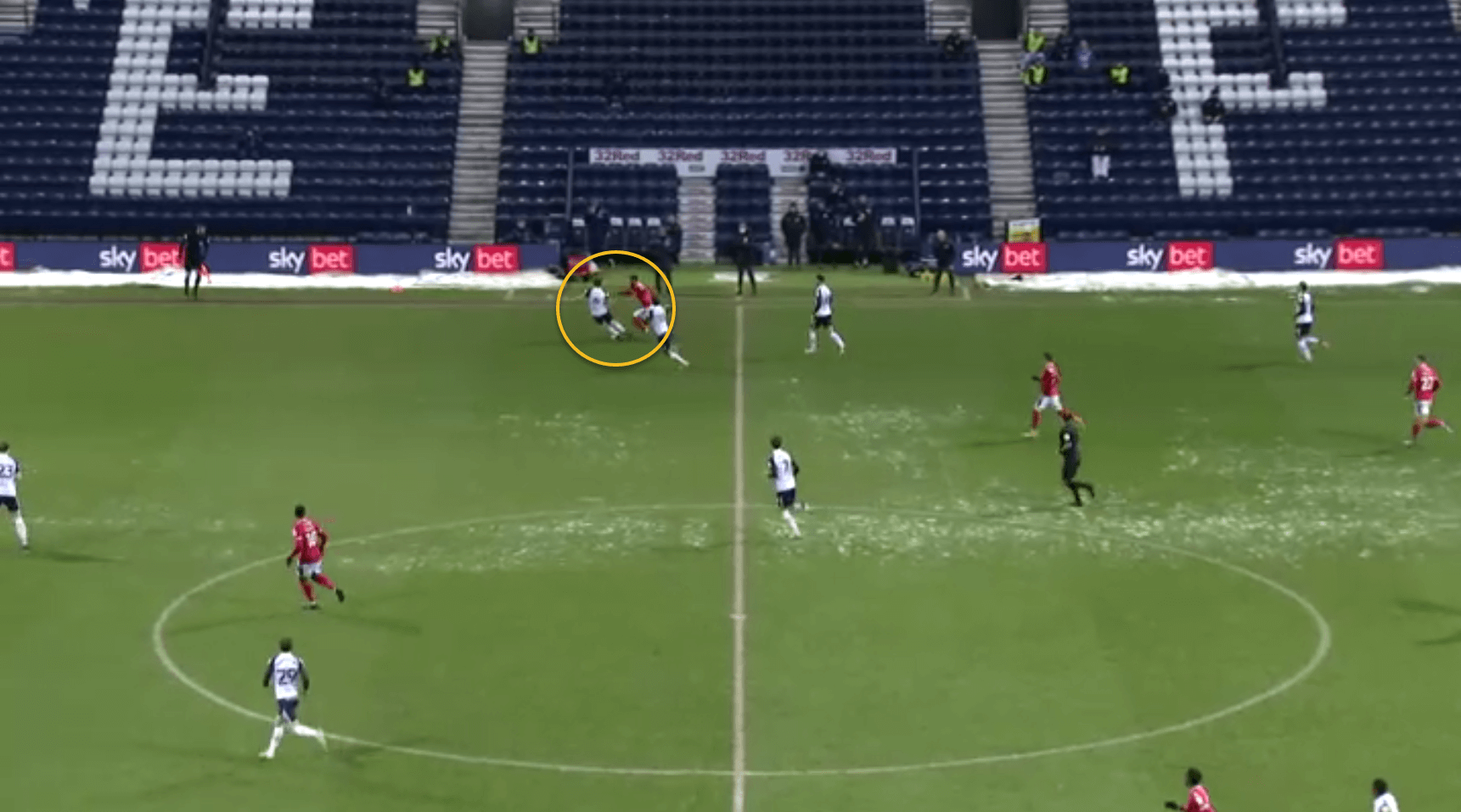
Again, this pays off as he is able to anticipate the attempted dribble and play the ball out for a throw-in.
Davies is a fairly active defender, in that he looks to get involved in duels, but only when the conditions suit him best so that he is able to come away with the ball more often than not. He is a good example of a defender who is aware of his physical limitations and therefore has worked on his game to mask those deficiences through his intelligence and anticipation, and these should mean that he is able to adapt to the expectations at Liverpool fairly well.
Final remarks
Ben Davies has been one of the most surprising transfers in recent times, but our analysis has shown that he does have quite a few promising traits that should theoretically mean that he fits in well with the Liverpool squad. It will now be down to him and fellow new arrival Ozan Kabak to try and nurse the team through to the end of the campaign, and while he does have big boots to fill at the heart of the defence, he has all the ingredients to be able to provide a competent option for Liverpool.





Comments